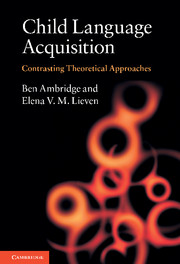Book contents
- Frontmatter
- Contents
- List of figures
- List of tables
- List of boxes
- List of summary tables
- Preface
- Acknowledgements
- 1 Introduction
- 2 Speech perception, segmentation and production
- 3 Learning word meanings
- 4 Theoretical approaches to grammar acquisition
- 5 Inflection
- 6 Simple syntax
- 7 Movement and complex syntax
- 8 Binding, quantification and control
- 9 Related debates and conclusions
- Notes
- References
- Author index
- Subject index
9 - Related debates and conclusions
Published online by Cambridge University Press: 05 June 2012
- Frontmatter
- Contents
- List of figures
- List of tables
- List of boxes
- List of summary tables
- Preface
- Acknowledgements
- 1 Introduction
- 2 Speech perception, segmentation and production
- 3 Learning word meanings
- 4 Theoretical approaches to grammar acquisition
- 5 Inflection
- 6 Simple syntax
- 7 Movement and complex syntax
- 8 Binding, quantification and control
- 9 Related debates and conclusions
- Notes
- References
- Author index
- Subject index
Summary
In Chapters 1–8, we have looked at the leading debates in the core areas of first language acquisition by monolingual, typically developing children. Our goal in this final chapter, before summarizing our previous discussions and drawing some conclusions, is to briefly outline some relevant issues which we have not been able to consider elsewhere. All bear in one way or another on the debates between (broadly speaking) generativist–nativist and constructivist approaches (even if only to suggest that there may be other ways of framing the debate). We do not attempt to adjudicate between the competing proposals in detail, as we have in the rest of the book, but simply to make readers aware of the more recent research on these issues.
Related debates
Modularity, domain specificity and brain localization
A traditional nativist view is that children are born with an innate language module. A module, as defined by Fodor (1983), is a closed system (encapsulation) that is not available to conscious awareness (unconscious), is mediated by a dedicated neural system (localization) and – crucially for our purposes here – deals exclusively with one particular information type (domain specificity); in this case, language. Although it is perfectly possible, in principle, for a modular system to be acquired as opposed to innate (e.g. Bates, 1993; Elman et al., 1996), the traditional view (e.g. Chomsky, 1957, 1965, 1988; Fodor, 1983) is that evidence for the domain specificity and localization of language constitutes evidence for an innate language module.
- Type
- Chapter
- Information
- Child Language AcquisitionContrasting Theoretical Approaches, pp. 359 - 376Publisher: Cambridge University PressPrint publication year: 2011



